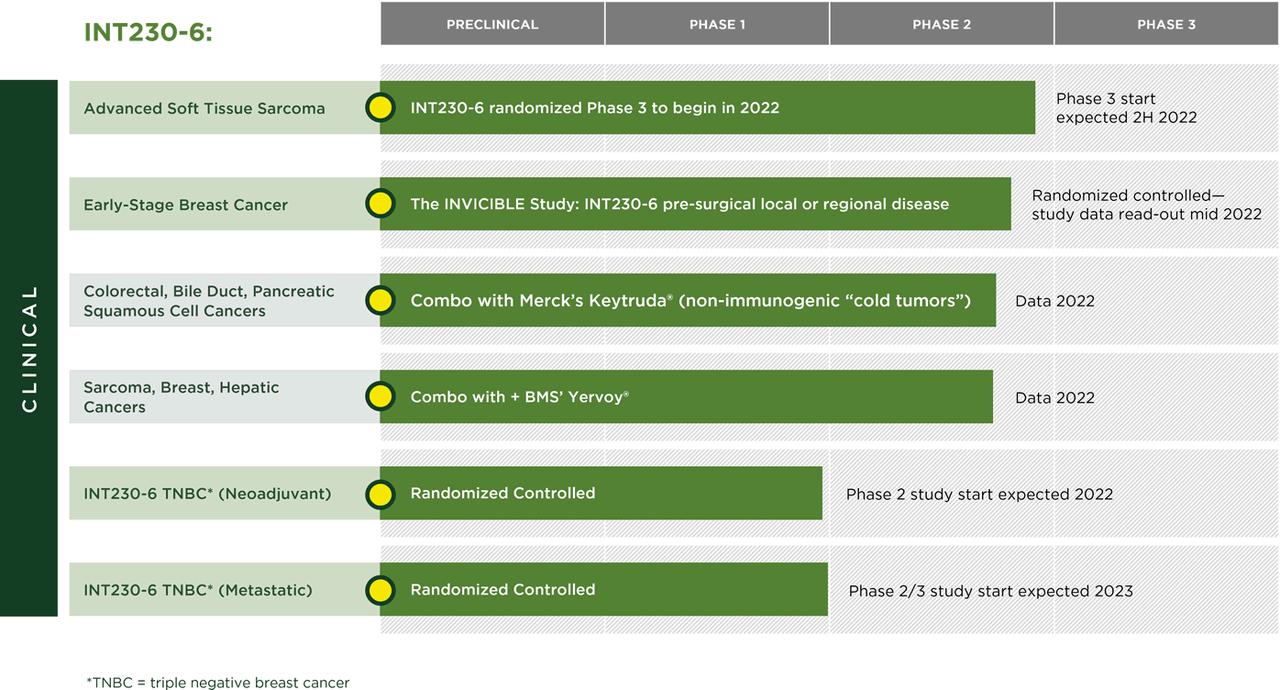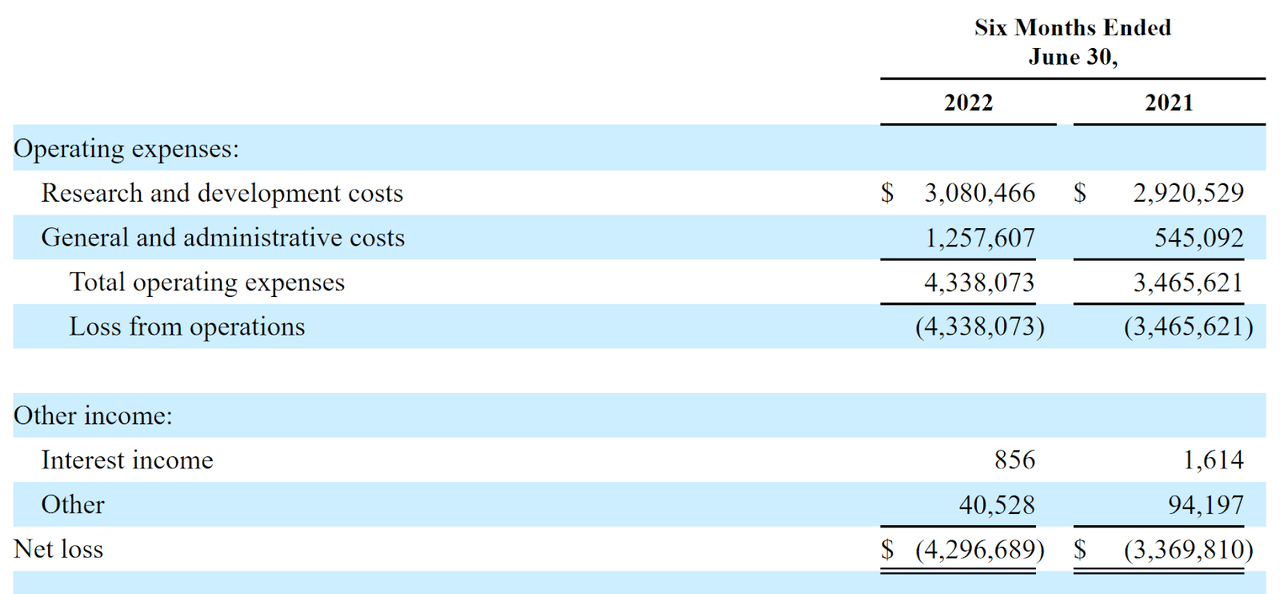sanjeri
What Is Intensity Therapeutics?
Westport, Connecticut-based Intensity Therapeutics, Inc. (INTS) was founded to develop tumor-killing injection drug combinations to improve the effectiveness of cancer treatments.
Management is headed by founder, president, Chairman and CEO Lewis H. Bender, who has been with the firm since inception in April 2012 and was previously CEO of Interleukin Genetics, a personalized medicine company.
The firm’s lead candidate, INT230-6, consists of two generic anti-cancer agents mixed with an “amphiphilic molecule” for use against various cancers.
INTS completed enrollment of its study IT-01 in June 2022 and is finalizing its report, which does include various adverse effects.
The company is also beginning Phase 2 studies for treatment of early- stage breast cancer, with 91 enrolled patients. Management expects Phase 3 studies for treating advanced soft tissue sarcoma to begin by the end of 2022.
Below is the current status of the company’s drug development pipeline:
Company Pipeline (Intensity Therapeutics)
Intensity has booked fair market value investment of $32.9 million as of June 30, 2022 from investors including Leonard Batterson, Larry Levy, Portage Biotech and Craig Duchossois.
Intensity’s Market & Competition
According to a 2018 market research report by Grand View Research, the global sarcoma drug market was an estimated $703 million in 2017 and is expected to grow to $1.1 billion by 2023.
This represents a forecast CAGR (Compound Annual Growth Rate) of CAGR (Compound Annual Growth Rate) of 8.5% from 2018 to 2023.
Key elements driving this expected growth are a strong increase in the adoption of newer drugs in development as well as a growing incidence of soft tissue sarcomas.
Also, chemotherapy and targeted therapies are the only approved treatments for sarcoma.
Major competitive vendors that provide or are developing related treatments include:
-
Kymera Therapeutics
-
Morphic Holding
-
RAPT Therapeutics
-
Arena Pharmaceuticals
-
Landos Biopharma
-
Seres Therapeutics
-
BioAtla
-
Epizyme
-
Nanobiotix
-
C4 Therapeutics
-
Others
Intensity’s drug candidate may also be applicable in other large cancer treatment markets.
Intensity Therapeutics’ IPO Date & Details
The initial public offering, or IPO, for Intensity is September 22, 2022, and will be available for retail investors to trade on the open market starting September 23, 2022.
(Warning: Compared to stocks with more history, IPOs typically have less information for investors to review and analyze. For this reason, investors should use caution when thinking about investing in an IPO, or immediately post-IPO. Also, investors should keep in mind that many IPOs are heavily marketed, past company performance is not a guarantee of future results and potential risks may be understated.)
Intensity intends to raise $10 million in gross proceeds from an IPO of its common stock, offering 2.22 million shares at a proposed midpoint price of $4.50 per share.
Certain existing shareholders have indicated a non-binding interest to purchase shares of up to $5.0 million in the aggregate at the IPO price.
Assuming a successful IPO, the company’s enterprise value at IPO would approximate $70.4 million, excluding the effects of underwriter over-allotment options.
The float to outstanding shares ratio (excluding underwriter over-allotments) will be approximately 12.36%.
Management says it will use the net proceeds from the IPO as follows:
approximately 25% toward initiating/conducting a Phase 3 sarcoma and/or Phase 2/3 early-stage breast cancer studies (IT-03 and IT-04);
approximately 35% toward our current clinical trials and related operations, including costs associated with the manufacturing of SHAO and INT230-6 for our clinical trials, conducting/completing our existing clinical programs, and maintaining our IND with the FDA, CTA with Health Canada as well as other regulatory filings with other countries;
approximately 5% toward development of our second product candidate, INT33X; and
approximately 35% toward general corporate purposes and working capital.
Based on our current plans, we believe that our existing cash and cash equivalents, together with the anticipated net proceeds to us from this offering, will enable us to fund our operations and capital expenditure requirements through December 31, 2023.
(Source – SEC)
Management’s presentation of the company roadshow is available here until the IPO is completed.
Regarding outstanding legal proceedings, management says the firm isn’t part of any legal proceeding that would have a material adverse effect on its financial condition or operations.
Listed bookrunners of the IPO are Roth Capital Partners and The Benchmark Company.
How To Invest In The Company’s Stock: 7 Steps
Investors can buy shares of the stock in the same way they may buy stocks of other publicly traded companies, or as part of the pre-IPO allocation.
Note: This report is not a recommendation to purchase stock or any other security. For investors who are interested in pursuing a potential investment after the IPO is complete, the following steps for buying stocks will be helpful.
Step 1: Understand The Company’s Financial History
Although there is not much public financial information available about the company, investors can look at the company’s financial history on their form S-1 or F-1 SEC filing (Source).
Step 2: Assess The Company’s Financial Reports
The primary financial statements available for publicly-traded companies include the income statement, balance sheet, and statement of cash flows. These financial statements can help investors learn about a company’s cash capitalization structure, cash flow trends and financial position.
The firm’s recent financial results are typical of a development stage biopharma in that they feature no revenue and significant R&D and G&A expenses associated with its pipeline development.
Below are the company’s financial results for the first half of 2022:
Operating Statement (SEC EDGAR)
As of June 30, 2022, the company had $1.7 million in cash and $4.8 million in total liabilities.
Step 3: Evaluate The Company’s Potential Compared To Your Investment Horizon
When investors evaluate potential stocks to buy, it’s important to consider their time horizon and risk tolerance before buying shares. For example, a swing-trader may be interested in short-term growth potential, whereas a long-term investor may prioritize strong financials ahead of short-term price movements.
Step 4: Select A Brokerage
Investors who do not already have a trading account will begin with the selection of a brokerage firm. The account types commonly used for trading stocks include a standard brokerage account or a retirement account like an IRA.
Investors who prefer advice for a fee can open a trading account with a full-service broker or an independent investment advisor and those who want to manage their portfolio for a reduced cost may choose a discount brokerage company.
Step 5: Choose An Investment Size And Strategy
Investors who have decided to buy shares of company stock should consider how many shares to purchase and what investment strategy to adopt for their new position. The investment strategy will guide an investors’ holding period and exit strategy.
Many investors choose to buy and hold stocks for lengthy periods. Examples of basic investing strategies include swing trading, short-term trading or investing over a long-term holding period.
For investors wishing to gain a pre-IPO allocation of shares at the IPO price, they would “indicate interest” with their broker in advance of the IPO. Indicating an interest is not a guarantee that the investor will receive an allocation of pre-IPO shares.
Step 6: Choose An Order Type
Investors have many choices for placing orders to purchase stocks, including market orders, limit orders and stop orders.
-
Market order: This is the most common type of order made by retail traders. A market order executes a trade immediately at the best available transaction price.
-
Limit order: When an investor places a buy limit order, they specify a maximum price to be paid for the shares.
-
Stop order: A buy-stop order is an order to buy at a specified price, known as the stop price, which will be higher than the current market price. In the case of buy-stop, the stop price will be lower than the current market price.
Step 7: Submit The Trade
After investors have funded their account with cash, they may decide an investment size and order type, then submit the trade to place an order. If the trade is a market order, it will be filled immediately at the best available market price.
However, if investors submit a limit order or stop order, the investor may have to wait until the stock reaches their target price or stop-loss price for the trade to be completed.
The Bottom Line
INTS is seeking public capital market investment to advance its drug development programs through and into clinical trials.
The firm’s lead candidate, INT230-6, consists of two generic anti-cancer agents mixed with an ‘amphiphilic molecule’ for use against various cancers.
The company is also beginning Phase 2 studies for treatment of early-stage breast cancer, with 91 enrolled patients. Management expects Phase 3 studies for treating advanced soft tissue sarcoma to begin by the end of 2022.
The market opportunity for treating the various cancers the firm is focused on is large and expected to grow substantially as the U.S. population ages and experiences greater incidence of cancer conditions.
Management hasn’t disclosed any major pharma firm collaboration and the company’s investor syndicate does not include any well-known life science venture capital firm.
Roth Capital Partners is the lead underwriter and IPOs led by the firm over the last 12-month period have generated an average return of negative (61.2%) since their IPO. This is a bottom-tier performance for all major underwriters during the period.
As for valuation, management is asking IPO investors to pay an enterprise value that is well below the typical range for a mainline biopharma firm at IPO.
While that apparent discount may seem enticing to life science investors, the firm is still thinly capitalized and its sub-$5.00 share price suggests the company cannot attract institutional, long-term hold investors.
I’m cautious about the company’s near-term prospects at this time, so I’m on Hold for its IPO.


Be the first to comment